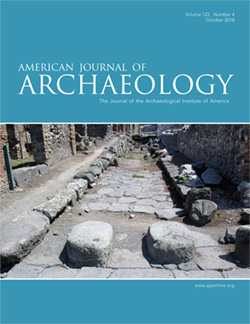AJA Open Access
BY-NCOctober 2018 (122.4)
Book Review
Évolution d’un quartier de Forum Iulii: Des Julio-Claudiens à Dioclétien
By Michel Pasqualini, Isabelle Rodet-Belarbi, and Véronique Blanc-Bijon
Reviewed by James F.D. Frakes
This book has the primary purpose of reporting on a series of salvage excavations that took place between 2004 and 2012 in Fréjus (southern France), the largest of which has brought to light the northwest corner of the city’s forum. The book is divided into four sections, which (1) describe the city’s regional circumstances, (2) present a chronological and site-specific analysis of the new findings in comparison with sites that are already known, (3) synthesize an overall picture of the city’s development with attention paid to material finds in various media, and (4) catalogue completely the new discoveries from the site, with ample photographs and thorough recording of measurements and media. Throughout the volume, the authors have provided numerous detailed and well-designed maps, laying out the chronological reading of site stratigraphy and placing new discoveries into the overall urban plan. One does wish that the excellent overall city plan were not bound precisely so that the seam runs through the main new excavation, but other maps ensure that total clarity is available. The whole volume is finished to the high standard typical of French archaeological publication, a model of careful fieldwork, clear description and analysis, and timely production for publication.
In addition to presenting the new findings, the authors have also taken the opportunity to interpret them in light of local and regional economic development, and this effort has produced wonderful results. Although there remain large gaps in our understanding of the ancient city, the summaries and comparisons with older excavation campaigns in Fréjus (most significantly the residential quarter of Clos-de-la-Tour but also including minor roadwork discoveries and smaller interventions) have gone far toward making the urban dynamics of Forum Iulii visible. The book deserves attention from those who are interested in Roman urban development in the provinces generally, and certainly from those who study Roman Gaul, for its content has granted the ancient city of Forum Iulii the full potential to stand alongside more frequently discussed sites such as Arles, Vaison-la-Romaine, or Saint-Romain-en-Gal/Vienne.
To the extent that Fréjus has appeared in urban histories of Roman Gaul or, most immediately, of Gallia Narbonensis, it has done so on the merits of its surviving urban armature—walls and gates, aqueducts, theater, and amphitheater—all of which are enlisted as additional supports for trends exemplified in what have been deemed more exciting ways by structures in Nîmes or Arles, for example. Despite habitual neglect, Fréjus stands apart from these other sites due to features such as the harbor works and the structures on the Butte-Sainte-Antoine, both of which have offered historians insight into the economic development of Gaul following the Caesarian conquests. It is this latter story—of the economic life of a city and its regional and provincial networks—that the present volume develops.
Forum Iulii was established ex nihilo by Roman agents, a circumstance that allows the authors of this study to examine the planners’ design strategies in comparison to the privileged models of urban planning that derive from Pompeii and Vesuvian towns. At Forum Iulii, by contrast, a regular street grid and complex subterranean water drainage systems could be established wholly and despite inconveniences of topography and slope. The resulting tissu urbain thus set up certain limitations and enduring persuasive effects that help explain subsequent developments in Fréjus. The city was laid out in two phases: an original Augustan grid oriented to the harbor works that had served Caesarian military purposes and a later extension to fill out the walled urban area on a grid oriented instead to the city gates and the Roman highway from the Alps to the Rhone (Via Aurelia?). The bulk of the city, including Clos-de-la-Tour and most of what has newly come to light, was developed in this later phase.
Whereas the discovery of the forum, including some of its ornamental apparatus of quadriporticus colonnades, does enhance the “urban image” of Fréjus in a way that resonates with other regional cities, the data from these new excavations show that, as the second century C.E. progressed, the infrastructure was increasingly dominated by artisanal production. The evenly parceled-out housing lots along the northern border of the city’s main plaza are shown to have been variously adapted over time. One house, set back a block from the forum itself, grew larger by annexing a neighboring house, but most others were subdivided and given over to commercial or production activities. By the middle of the third century, many of the sidewalks that Fréjus’ planners had envisioned as colonnades along prominent streets had been closed in and segmented by the buildings they fronted, becoming storage or work spaces and disrupting a unified streetscape. The gradual process of desertion and dereliction began after the reign of Diocletian, although the city never truly disappeared, hosting a bishop by 374 C.E. in a village cluster that had almost totally “forgotten” the Augustan and Tiberian grids. The authors suggest that loss of the artisanal activity during the second and third centuries likely resulted from a move to nearby villas such as St.-Hermentaire (113).
As mentioned earlier, the book will be a valuable resource to those who study ancient urban planning, the Roman economy, and Gallic urbanism, history, and culture. It provides evidence for production and distribution systems related to wood harvesting, clay works and ceramics, mineral extraction, boat building and fishing, and agriculture and husbandry. There is perhaps less here to interest historians of art and visual culture, but for anyone tracking terracotta antefixes, Bacchus-headed herms, marble oscilla, images of Fortuna, or ceramic molds (of lions), there are a few new finds here to ponder. Finally, fragments of mosaic flooring and painted walls add to a growing corpus of design history in the Roman provinces.
James F.D. Frakes
University of North Carolina at Charlotte
jffrakes@uncc.edu
